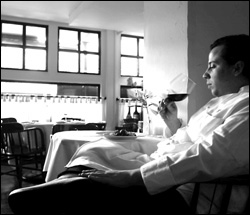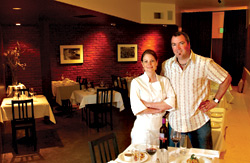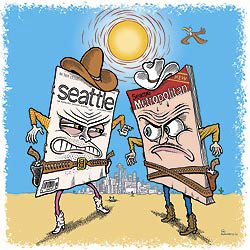Reviewing a restaurant that’s older than you can be daunting. Around since 1977 (I came along two years later), Il Bistro doesn’t just epitomize Seattle fine dining today; it was one of a handful of ambitious restaurants that sparked the ascent of high-end eating in the city during the past 25 years. And to irreverent younglings like me, the place is proof that not everything hailing from a prior generation should be rejected out of hand.
Silver-haired manager Randy Brown was a bartender at Il Bistro when the place first opened its doors, and his experience shows: Brown’s soft-spoken manner and steady gaze bespeak the confidence of a man unconcerned with the ebb and flow of industry hype. As recently as the late ’70s, upscale dining seemed novel to many Seattleites. Brown remembers that era quite well. “People would come in [and say], ‘Well, I thought this was Italian food,'” he recalls. “You know, people were used to the pizza and spaghetti. Well, yeah, it’s Italian, but Italians eat chicken, they eat steak, they eat veal.” Without condescension, Il Bistro staffers have long been educating customers, other restaurants, and even the state liquor board on the subject of fine dining. So while you may never have visited the cavelike dining room to the left of the Pike Place Market entrance, you’ve probably observed its influence on local restaurants ranging from Salty’s to the Queen City Grill (opened by Il Bistro’s original owner, Peter Lamb).
It all began with coffee. “We had the second commercial-grade espresso machine in the city of Seattle,” Brown says. “Starbucks [in the Market] had the other one. They made our own mix of coffee, called the ‘Bistro Blend,’ just for this restaurant. People were coming in and going, ‘God, what is that?’ Well, it’s an espresso machine.”
Next came the Scotch collection. In the ’70s, the Washington State Liquor Control Board showed little interest in sophisticated beverages—a vexing predicament for a restaurant hoping to introduce diners to a higher breed of drink. “At the time when we opened,” Brown explains, “we could get some Glenlivet, Glenfiddich, a couple of the more popular single malts.” Current owner Dale Abrams adds: “We’ve educated the liquor stores, and they’ve brought in Scotches for us. We’ve educated with grappas as well, and some single-barrel bourbons. Sometimes we’ll be the only one in the state to have it, ’cause we’re the ones who ordered it.”
The restaurant’s pioneering work has paid off: Il Bistro stocks four dozen single-malt and blended Scotches, along with two dozen bourbons and a hefty assortment of grappas, liqueurs, cognacs, whiskeys, et al. Though the dining room merits the bulk of a reviewer’s attention, it’s worthwhile to consider how assiduously Il Bistro has developed the more casual side of the establishment, turning a simple L-shaped lounge into a nearly unbeatable bar.
But on to the food. Despite Il Bistro’s storied past—Lauren Bacall has eaten there, Pearl Jam have partied there, and comedian Red Skelton once sent back a plate of tortellini he claimed was “ice cold”—the kitchen isn’t mired in nostalgia. Chef Maro Gjurasic runs a forward-thinking operation he characterizes as “what an Italian chef would do living here [in the Northwest].” Gjurasic grew up in a Croatian household, so his respect for Mediterranean flavors is great, but his and Abrams’ vision for the restaurant gracefully accommodates local ingredients, as well.
While some Italian eateries around town produce traditional cuisine that evokes ancient nonne stirring sauce, Abrams and Gjurasic take risks, as with their endive and Dungeness crab salad ($8), which collides a trio of clean flavors: sweet crabmeat, bitter endive, and a cool mint dressing that catches you off guard. Compared to Il Bistro’s antipasto plate ($12), their rigatoni bolognese ($14), and the tomato-bathed seafood opera that is their cioppino ($24), this salad is a risky, nouveau proposition, and the finished product is slightly overwhelming. The crab’s ocean flavor never quite complements (or opposes) the endives’ bitterness, and the mint, though a bold attempt at bridging the two, doesn’t quite make the connection.
But slight misfires happen when a kitchen is truly alive, and there’s a real sense of play at Il Bistro, which means Gjurasic is free to experiment and tinker. As a result, his kitchen brings an unusual boldness to traditional fare, including the menu’s obvious showpiece, the caretto d’agnello ($38), a rack of lamb in rosemary -sangiovese sauce. The meat cuts beautifully, and the contrast between its sunrise-pink interior and lightly charred surface is lovely.
Equally effective, the black fettuccini con frutti di mare ($18) takes “shellfish” very literally; covered with clams and mussels, a bed of squid-ink pasta peeks shyly out from beneath the armada of shells. The dark, spicy, Sicilian-style sauce makes excellent use of the region’s characteristic flavors, including anchovies, and all the seafood is bracingly fresh.
One mark of superb cooking is the use of rich flavors—not heavy textures or overlarge portions—to satisfy. After three sumptuous courses, my companion and I still had room for dessert, so we ordered strawberries with balsamico and mascarpone ($9). The vinegar, berries, and cheese were layered, parfait-style; the balsamic, we learned, had been aged for 25 years. No surprise there—its complex, slightly raisiny zing was an ideal accompaniment to both the sweetness and creaminess of the dessert. Add in the last tart sips of our 1999 Monsanto Chianti ($37/bottle), heady with cloves, and you have a painterly masterpiece, a meal that stands up to any Italian food (or chophouse fare) in town. And rest assured: This Seattle survivor still has plenty to teach us about fine food done right.
Il Bistro, 93A Pike St., 206-682-3049, PIKE PLACE MARKET. Dinner 5:30–10 p.m. daily; late-night menu until 1 a.m.








